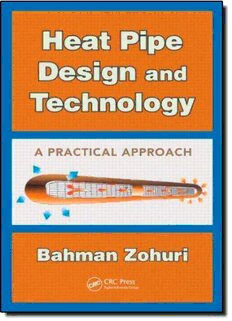Table Of ContentHeat Pipe
Design
and
Technology
Heat Pipe
Design
and
Technology
A PRACTICAL APPROACH
Bahman Zohuri
Boca Raton London New York
CRC Press is an imprint of the
Taylor & Francis Group, an informa business
MATLAB® and Simulink® are trademarks of The MathWorks, Inc. and are used with permission. The
MathWorks does not warrant the accuracy of the text or exercises in this book. This book’s use or
discussion of MATLAB® and Simulink® software or related products does not constitute endorsement
or sponsorship by The MathWorks of a particular pedagogical approach or particular use of the MAT-
LAB® and Simulink® software.
CRC Press
Taylor & Francis Group
6000 Broken Sound Parkway NW, Suite 300
Boca Raton, FL 33487-2742
© 2011 by Taylor and Francis Group, LLC
CRC Press is an imprint of Taylor & Francis Group, an Informa business
No claim to original U.S. Government works
Printed in the United States of America on acid-free paper
10 9 8 7 6 5 4 3 2 1
International Standard Book Number: 978-1-4398-4523-3 (Hardback)
This book contains information obtained from authentic and highly regarded sources. Reasonable
efforts have been made to publish reliable data and information, but the author and publisher cannot
assume responsibility for the validity of all materials or the consequences of their use. The authors and
publishers have attempted to trace the copyright holders of all material reproduced in this publication
and apologize to copyright holders if permission to publish in this form has not been obtained. If any
copyright material has not been acknowledged please write and let us know so we may rectify in any
future reprint.
Except as permitted under U.S. Copyright Law, no part of this book may be reprinted, reproduced,
transmitted, or utilized in any form by any electronic, mechanical, or other means, now known or
hereafter invented, including photocopying, microfilming, and recording, or in any information stor-
age or retrieval system, without written permission from the publishers.
For permission to photocopy or use material electronically from this work, please access www.copy-
right.com (http://www.copyright.com/) or contact the Copyright Clearance Center, Inc. (CCC), 222
Rosewood Drive, Danvers, MA 01923, 978-750-8400. CCC is a not-for-profit organization that pro-
vides licenses and registration for a variety of users. For organizations that have been granted a pho-
tocopy license by the CCC, a separate system of payment has been arranged.
Trademark Notice: Product or corporate names may be trademarks or registered trademarks, and are
used only for identification and explanation without intent to infringe.
Visit the Taylor & Francis Web site at
http://www.taylorandfrancis.com
and the CRC Press Web site at
http://www.crcpress.com
This book is dedicated to my wife Firouzeh,
my daughters Natasha and Natalie, and my son Sasha.
I would also like to dedicate this book to my mother Marzieh
and my father Akbar.
Without the encouragement of these individuals,
this book could not have been written.
Disclaimer
This document is protected under the copyright laws of the United States and=or
othercountriesasanunpublishedwork.Thisdocumentcontainsinformationthatis
proprietaryandconfidentialtoGalaxyAdvancedEngineeringand=oraffiliatesorits
technicalalliancepartners,whichshallnotbeduplicated,used,ordisclosedinwhole
orinpartforanypurposeotherthantoevaluateGalaxyAdvancedEngineering,Inc.
and=or its affiliate(s). Any use or disclosure in whole or in part of this information
withouttheexpresswrittenpermissionofGalaxyAdvancedEngineering,Inc.and=or
its affiliate(s) isprohibited.
(cid:1)2006–2010GalaxyAdvancedEngineering,Inc.and=oritsaffiliate(s)(Unpub-
lished). Allrights reserved.
TheProvenCoursemethodologyisacomponentofGalaxyAdvancedEngineer-
ing’s Proven Coursedelivery framework and contains process, templates, and tech-
niquesusedtodeliverGalaxyAdvancedEngineeringservices.
Proven CoursegSM, Galaxy Advanced EngineeringTM, and GAETM Business
EmpoweredTM are trademarks or service marks of Galaxy Advanced Engineering,
Inc.and=orits affiliates.
vii
Contents
Preface...................................................................................................................xvii
Acknowledgments..................................................................................................xxi
Author..................................................................................................................xxiii
Nomenclature........................................................................................................xxv
Chapter 1.................................................................................................................1
1.1 Introduction.................................................................................................... 1
1.2 History........................................................................................................... 2
1.3 Description and Typesof Heat Pipes............................................................ 3
1.4 Principles ofOperation................................................................................ 15
1.4.1 Container........................................................................................ 15
1.4.2 WorkingFluid................................................................................ 16
1.4.3 Wick orCapillary Structure........................................................... 16
1.4.4 SinteredPowder.............................................................................. 17
1.4.5 GroovedTube................................................................................. 18
1.4.6 Screen Mesh................................................................................... 18
1.4.7 How Heat Pipes Work.................................................................... 18
1.4.8 Heat Pipe Assemblies: DesignGuidelines..................................... 20
1.4.9 Orientation with respect toGravity................................................ 20
1.4.10 Temperature Limits........................................................................ 21
1.4.11 Heat Removal................................................................................. 21
1.4.12 Reliability....................................................................................... 22
1.4.13 Forming or Shaping........................................................................ 22
1.4.14 Effects of Length and PipeDiameter............................................. 22
1.4.15 Wick Structures.............................................................................. 22
1.5 Operating Ranges........................................................................................ 23
1.6 Constraints................................................................................................... 25
1.7 Lesson(s) Learned........................................................................................ 30
1.8 Applications................................................................................................. 30
1.9 Summary...................................................................................................... 34
References.............................................................................................................. 37
Chapter 2...............................................................................................................39
2.1 Heat Pipe Theory......................................................................................... 39
2.2 Fundamental Considerations....................................................................... 39
2.3 Operating Characteristics of Heat Pipes...................................................... 42
2.4 Operating Limits.......................................................................................... 45
2.4.1 Capillary Pressure Differences or Balance..................................... 45
2.4.1.1 Normal Hydrostatic Pressure.......................................... 56
2.4.1.2 AxialHydrostatic Pressure............................................. 56
2.4.2 Capillary Pressure attheLiquid–Vapor Interface.......................... 57
ix
x Contents
2.4.3 TurbulentandLaminar Flow of theVapor.................................... 60
2.4.4 One-Dimensional Two-PhaseFlow............................................... 66
2.4.4.1 What IsTwo-Phase Flow?.............................................. 67
2.4.4.2 Methods ofAnalysis....................................................... 67
2.4.4.3 Flow Regime................................................................... 68
2.4.5 Heat Transfer.................................................................................. 69
2.5 Sonic Limit orChoking............................................................................... 73
2.5.1 Sonic Limitationand Startup Problem
of Heat Pipes.................................................................................. 81
2.6 Entrainment Limit........................................................................................ 82
2.7 Wicking=Capillary or Circulation Limit...................................................... 85
2.7.1 Liquid Pressure Drop..................................................................... 88
2.7.2 VaporPressure Drop...................................................................... 94
2.7.3 Capillary or Wick Limitation Analysis
on Heat TransportCapability....................................................... 103
2.7.4 Characteristics of Wick................................................................ 110
2.7.4.1 Single-Layer Wick........................................................ 112
2.7.4.2 Two-LayerWick........................................................... 112
2.7.4.3 Artery Wick.................................................................. 113
2.7.4.4 Monogroove Wick Heat Pipe....................................... 115
2.7.4.5 Variable Thickness Wick.............................................. 117
2.7.5 What Is a Wick Structureand How Does
ItAffectthePerformance ofthe Heat Pipes?.............................. 117
2.7.6 New Wick Structurefor Low-Temperature
and Higher Heat Transfer in Heat Pipes...................................... 119
2.7.7 EffectiveThermal Conductivity
of Wick Structure......................................................................... 121
2.8 BoilingLimit............................................................................................. 126
2.9 Viscous Limit............................................................................................ 139
2.10 Condenser Limit........................................................................................ 141
2.11 Transport Limitations................................................................................ 141
2.12 Working Fluid........................................................................................... 150
2.12.1 Operating Temperature Range..................................................... 151
2.12.2 Heat Transfer Requirements......................................................... 151
2.12.3 Expected Body-ForceField.......................................................... 152
2.12.4 Tolerance ofWick Structure toBoiling....................................... 153
2.12.5 ConventionalorVariableConductanceHeatPipe...........................155
2.12.6 Special Requirements................................................................... 156
2.12.7 Materials Compatibility andStability.......................................... 156
2.13 Heat Pipe Startup Characteristics and Control.......................................... 158
2.13.1 Transientof Heat Pipe Startup Characteristics
and Control................................................................................... 159
2.13.2 Normal Startup Characteristics..................................................... 162
2.13.3 Frozen and Startup Characteristics............................................... 163
2.14 Summary.................................................................................................... 165
References............................................................................................................ 168

